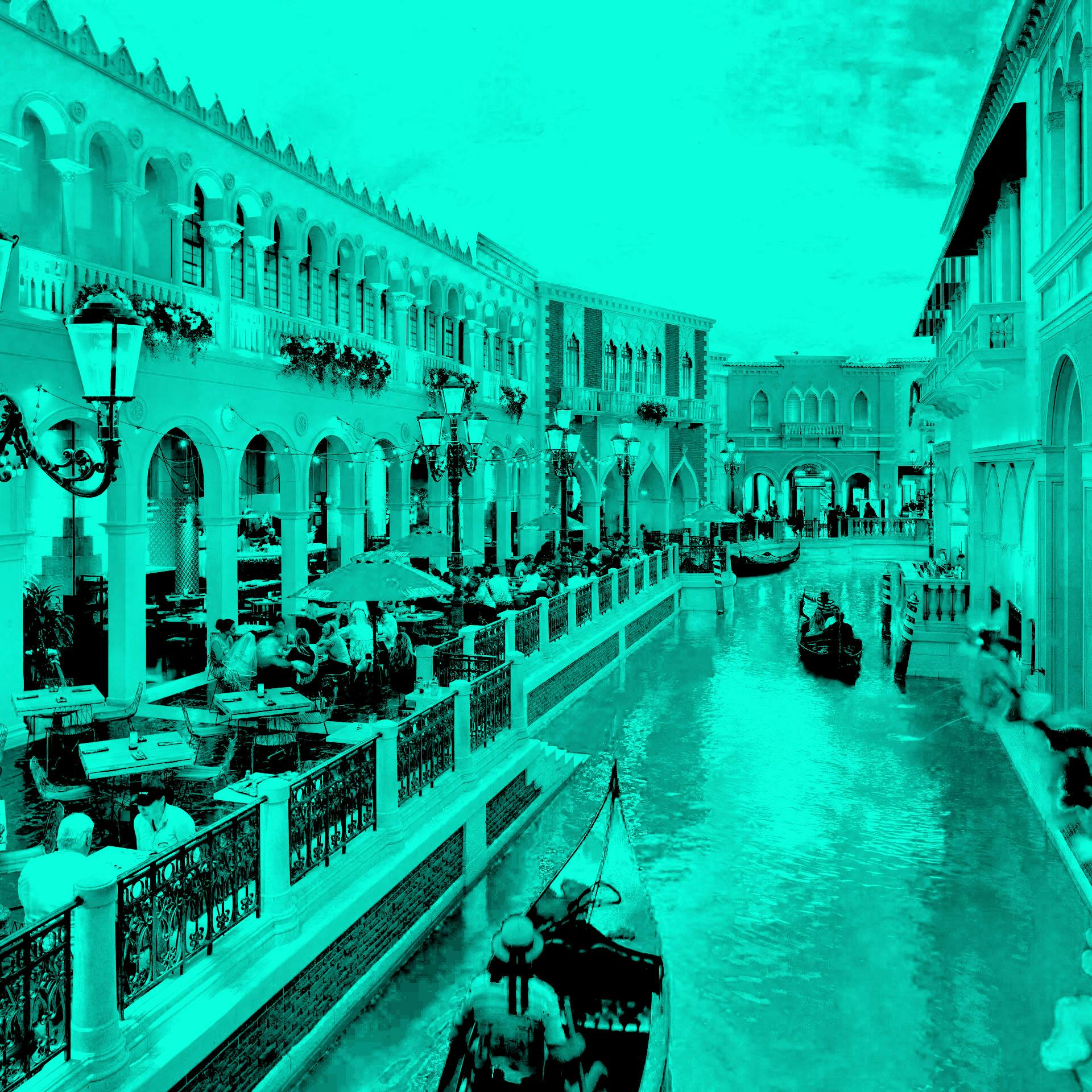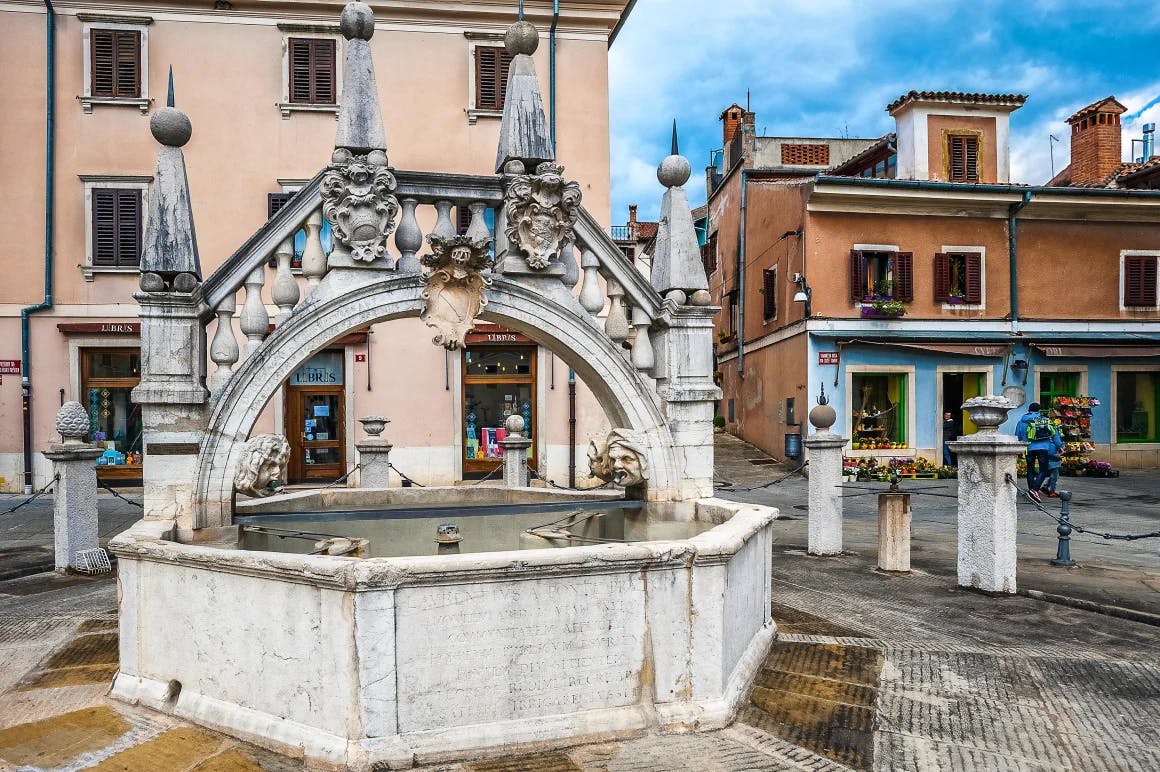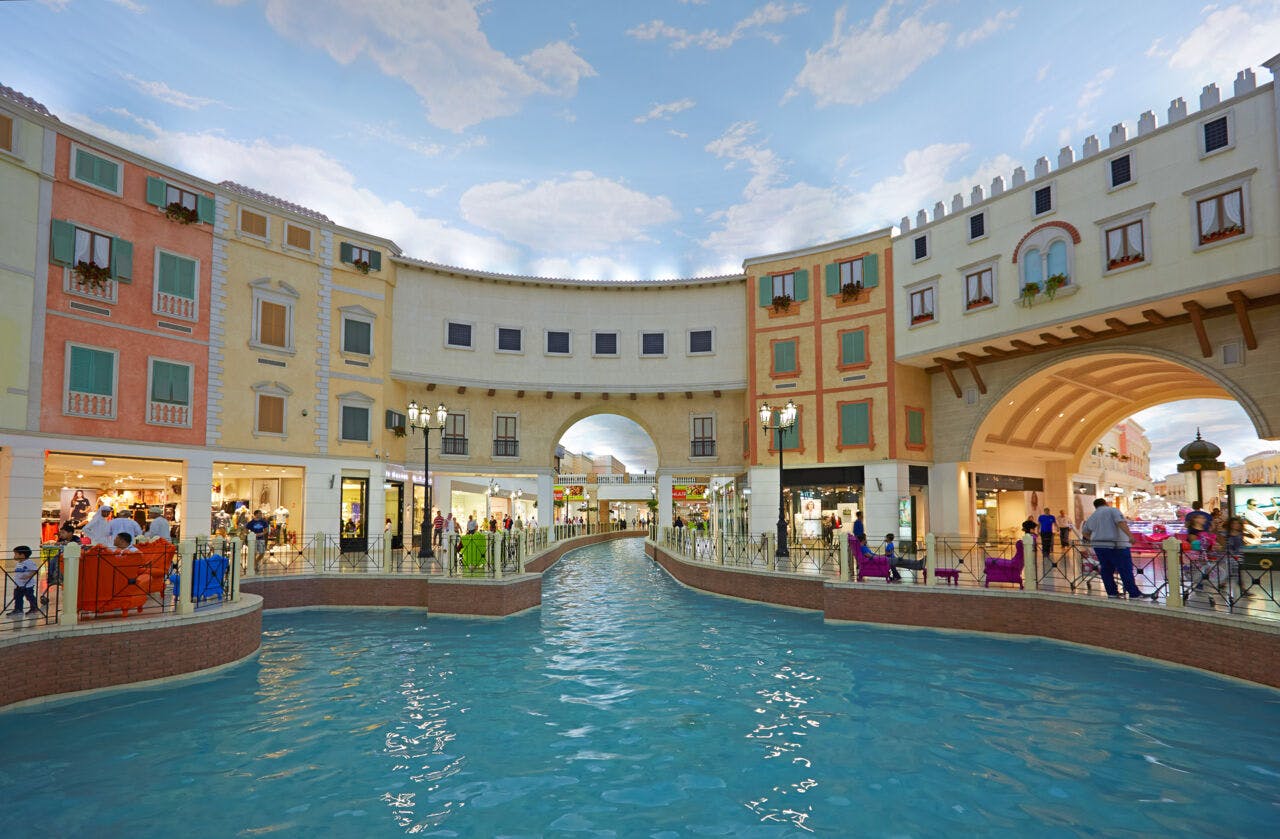The Presence of the Past
Versions of Venice have been built around the world, in Las Vegas and beyond, embracing the city as a fantasy.

Built in the late 1990s, the Las Vegas casino hotel The Venetian Las Vegas was developed by Las Vegas Sands, and designed to look like Venice on the recommendation of the owner’s wife. It took two architectural firms, a team of industrial designers, two Venice historians, and hundreds of painters and sculptors to bring together the resort, which Venice’s then mayor Massimo Cacciari described as a “mega-galactic example of kitsch.” From the Las Vegas Strip, you get a view of a model of the ‘Doge’s Palace’ overlooking the 'Grand Canal.’ There’s a ‘Rialto Bridge,’ a replica of St. Mark’s Campanile — which at one point was going to feature a revolving restaurant — an indoor plaza with a recreation of St. Mark’s Square with a sky-painted ceiling, and ‘The Grand Canal Shoppes.’ The ‘Grand Canal’ itself extends from the portico of the casino resort, through to the interior along a network of waterways that can be navigated on a gondola, led by singing gondoliers.
Although versions of Venice are often viewed as “mega-galactic kitsch,” the city itself once sought to scale and replicate its image, with odes to the city cropping up along the Adriatic Coast. Over a period of 1000 years from 697 CE to 1797 CE the Republic established an empire, with palaces built ‘in the style of’ Doge Palace, wells and bell towers in Venetian-style squares, and towns carrying the lion of St. Mark cropping up in Slovenia, Croatia, Albania, Greece, Crete and Cyprus, albeit minus the canals. More recently — as well as Venice being reproduced by Venice, and Venetian traditions being reproduced internationally and sold back to the city — versions of Venice have been built around the world, in Las Vegas and beyond, embracing the city as a fantasy, but also for its feats of engineering.

The Da Pontejev fountain in Koper, Slovenia is a replica of Venice’s Rialto Bridge. (Alamy)
The Venetian Macao opened around a decade after The Venetian Las Vegas, modelled on the latter resort and built on reclaimed land. It has all the attractions of The Venetian Las Vegas — blown up in scale — along with a run of buildings along the waterfront of Macao’s ‘Grand Canal,’ which give more of a general ‘Venice’-vibe, standing on an innovative system of pilings, like the city itself.
The Villaggio Mall in Doha, Qatar has a generally ‘Italian’ theme, with one section of shops defined as ‘Venice’ by the network of canals and gondolas. The theme is extended and reinterpreted by the mall’s amusement park, named ‘Gondolania,’ but otherwise seeming more generally ‘amusement’-themed. The Venice mall aesthetic has also been adopted in Thailand, in the Philippines — with an open-air ‘Venice Grand Canal’ mall — and at the Grand Venice Mall in India (and probably more). In Dalian, a port city in China, there is a ‘water town’ built in the style of Venice, with four kilometres of manmade canals designed with the hope of reducing traffic and improving air quality. Reproducing the Venice vibe — which includes a St. Mark’s Bell Tower — cost around 500 million Euros, and ten years after it opened to the public it is mostly a ghost town, with canals only filled during high season for gondola rides, rather than being the regular route for commuters.
Although versions of Venice are often viewed as “mega-galactic kitsch,” the city itself once sought to scale and replicate its image, with odes to the city cropping up along the Adriatic Coast.
The complex network of canals, bridges, narrow streets, and occasional grand openings in Venice, Italy is hard to comprehend as a visitor — and seemingly for mapping apps, too. To get around, I have found that I need to be open to getting lost, finding my way through a cycle of wrong turns, loops and dead ends, following my instincts as if blindfolded in a game of Marco Polo. Giving in like this means opening up to a different kind of time, less efficient, observing places, symbols and forms that can ground your sense of direction and place. But these observations aren’t necessarily reliable, with the nature of Venice as a city built on reflections and labyrinthine tricks of the light. Those from the water, or between structures that mirror each other — narrow views that replicate where you have just been or where you are trying to go, and the symbols and images that surround you on repeat — of Murano glass, carnival masks, handmade lace, and porcelain dolls, the lion of St. Mark, or washing drying on criss-crossing threads — each view as picture-perfect as the last.
It lends itself to being captured, as in photographed, or drawn, or painted — remembered, memorialised — but also captured in the ways that we try to hold a moment in time by associating it with an object. A souvenir, something that we believe will keep that moment with us, a symbol of our connection to a place, and our right to it staying as we remember it. The same could be said of so many places, but Venice in particular lends itself to becoming an image. The Carnival of Venice has been held since the Middle Ages, with a few long gaps as it was outlawed and brought back into favour; since 1979, the streets have been filled with masks every year, after a group of university students started making some for the tourist trade. Outside of carnival season, masks appear at workshops and studios, in shop windows, on doorways and among street trade stalls, alongside many other emblematic trades of the city.

The Venetian Las Vegas. (Thomas Hart Shelby/Goat Rodeo Productions)
The working of lace was first associated with Venice due to the dexterity of people making and repairing fishing nets, with traditional Burano lacemaking becoming popular in the 1500s during the Republic of Venice, until its collapse in the late 1700s. Lacemaking continued as a family business on Burano, and is now a practice maintained by a few skilled artisans working mostly privately at home, with replicas of the intricate pieces being attempted in factories at scale as souvenirs.
Venetian glass, typically made on the island of Murano since the 1200s, has a long history of innovations and mastery. Murano had Europe’s finest makers of glass from the High Middle Ages to the Italian Renaissance, and although now popular with tourists, Murano maintains workshops and factories. But many of the glasses, vases, and glass objects that claim to be Murano glass, don’t have a relationship to its craft or expertise, and make their journey to Venice across vast oceans rather than from across the lagoon. The masks, lace and glass, as well as porcelain dolls, marbled paper, fans, striped shirts, and more loosely ‘Italian’ theme souvenirs — Statue of David aprons, football shirts, and Campari or pasta fridge magnets — are often made in China, even when the stand reads ‘NO CHINA SOLO MADE IN ITALY.’
These versions of Venice, which make their way back-and-forth as a sort-of material impression of the relationship between Marco Polo and Kublai Khan, are looked down on as cheap bootlegs. And while on one hand that’s true, on the other, with its history as a trading centre, making products that would be sent around the world, a full refusal of the souvenir trade doesn’t feel right.
These versions of Venice are looked down on as cheap bootlegs. And while on one hand that’s true, on the other, with its history as a trading centre, a full refusal of the souvenir trade doesn’t feel right.
The first international architecture exhibition of La Biennale di Venezia was held in 1980, La presenza del passato — the presence of the past — directed by Paolo Portoghesi. A consideration of Postmodernism, the main exhibition was the Strada Novissima, a theatrical ‘street’ set up with a long row of facades each designed by a different architect, including Rem Koolhaas, Robert Venturi, and Ricardo Bofill. In some ways Postmodernism feels antithetical to Venice, but the versioning of the city — both by and of it — is precisely that, with traditions and innovations becoming images and symbols to be made anew. But as much as Venice lends itself to becoming an image, through photographs, souvenirs, and the ‘dedications’ of casino and shopping mall proprietors, it is a nostalgic one. An image intended to hold the memory in place, and hold a place in a moment, casting a shadow over the possibility of presence when looking into the past. In Invisible Cities, Italo Calvino recites an imagined conversation between Kublai Khan and Marco Polo about the many cities Polo has described. Khan says “There is still one of which you never speak… Venice,” to which Polo replies: “Memory's images, once they are fixed in words, are erased… Perhaps I am afraid of losing Venice all at once, if I speak of it, or perhaps, speaking of other cities, I have already lost it, little by little.”
Billie Muraben is a writer, curator, and editorial consultant based in London. She is Editor of interiors magazine, TON.
Her features and essays on design, culture, and spatial spectacle have appeared in publications including Aperture, Pin Up, Port, Tank, and The World of Interiors, as well as contributing to exhibition titles and catalogues raisonnés. She is co-author of ‘Dope and Diamonds: A Lana Del Rey Reader’, and author of ‘Eau! A brief history of tricksy water from Vegas to Versailles’, both published by Chateau International.

The Villaggio Mall in Qatar. (visitqatar.com)
Billie Muraben is a writer, curator, and editorial consultant based in London. She is Editor of interiors magazine, TON.
Her features and essays on design, culture, and spatial spectacle have appeared in publications including Aperture, Pin Up, Port, Tank, and The World of Interiors, as well as contributing to exhibition titles and catalogues raisonnés. She is co-author of ‘Dope and Diamonds: A Lana Del Rey Reader’, and author of ‘Eau! A brief history of tricksy water from Vegas to Versailles’, both published by Chateau International.